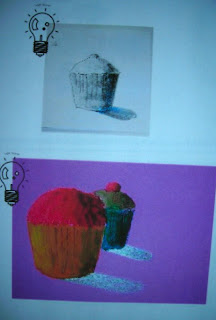Are we all ready for a new year of ART??!!
Each grade level I have worked with this school year has started with studying light source and shading cylinders. 5th graders will be doing the same, only with a different project. We are starting the new year with a look at California artist, Wayne Thiebaud.
Wayne Thiebaud was born on Nov. 23, 1920 in Mesa, Arizona. He moved to Long Beach, California with his family when he was a baby.
Thiebaud, which is pronounced “Tee-bo,” worked for more than 10 years in New York and Hollywood, CA as a cartoonist and a commercial artist in advertising. From 1942 to 1946 he served in the US Army Air Force. Then, using his GI bill, he went to college at San Jose State College and California State University at Sacramento. In 1951 he began teaching at Sacramento Junior college and after 8 years became an art professor at University of California at Davis, where he continued to work throughout his career. He is currently Professor Emeritus there.
Thiebaud is best known for his paintings of lines or arrays of foods found in diners or bakeries (like pies, cakes, etc.). As a young man, in Long Beach, he actually worked in a diner called Mile High and Red Hot. “Mile High” was ice cream and “Red Hot” was a hotdog. While he often painted groups of common objects, he also painted landscapes and figures.
Wayne Thiebaud is often associated with pop art, although he was painting his objects slightly before most of the well known pop artists had started their work. Thiebaud uses heavy pigment and strong colors in his work and his paintings almost always have well-defined shadows that are seen in advertisements. In 1994 he was presented the National Medal of Art by President Clinton.
After working on a Smartboard lesson below, where kids practice arranging 3 cupcakes using overlapping and decreasing size to create the illusion of space, fifth graders will make paper mache cupcakes that they can later use as a model for drawing. The largest cupcake is an infinite cloner. Students clone 2 more cupcakes, reducing their size, placing them “behind” the first cake and erasing unnecessary lines. We'll then talk about light source and shadows.
For the paper mache, students will start with a cupcake liner, a piece of newspaper and some masking tape.
Working with partners, they'll crumple the paper loosely to fit in the cupcake liner and tape crosswise (like a hot cross bun).
The next step is to paper mache the cupcake using newspaper strips and a mixture of flour and water. Given a larger budget, I'd use starch, and I know there are a lot more complicated mixtures that involve cooking, but I have used flour thinned with some warm water and have had great results. I just start with about 1/4 cup of flour in a pie tin, add a bit more than 1/4 cup warm water and have the kids mix it with their fingers until it is smooth and a creamy consistency. This should be enough for 2 kids to share. Then, of course, they apply the soaked newspaper strips. One layer is enough for this project as long as it is smooth.
When the cupcakes are dry, kids will paint with acrylics.
My plan is to have the children work together to arrange their cupcakes in an array "installation" that they can sketch, noticing shadows and using shading to give their drawing a 3-D look. Then they'll decorate a small piece of thick matt board as a base and we'll glue gun the cupcake to it. Voila -- a cupcake sculpture to take home!! I'll post the results of the sculptures, the arrays and the drawings when they are done.



































